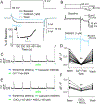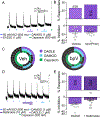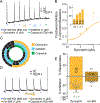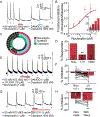Distribution of functional opioid receptors in human dorsal root ganglion neurons
- PMID: 32102022
- PMCID: PMC7305987
- DOI: 10.1097/j.pain.0000000000001846
Distribution of functional opioid receptors in human dorsal root ganglion neurons
Abstract
Preclinical evidence has highlighted the importance of the μ-opioid peptide (MOP) receptor on primary afferents for both the analgesic actions of MOP receptor agonists, as well as the development of tolerance, if not opioid-induced hyperalgesia. There is also growing interest in targeting other opioid peptide receptor subtypes (δ-opioid peptide [DOP], κ-opioid peptide [KOP], and nociceptin/orphanin-FQ opioid peptide [NOP]) on primary afferents, as alternatives to MOP receptors, which may not be associated with as many deleterious side effects. Nevertheless, results from several recent studies of human sensory neurons indicate that although there are many similarities between rodent and human sensory neurons, there may also be important differences. Thus, the purpose of this study was to assess the distribution of opioid receptor subtypes among human sensory neurons. A combination of pharmacology, patch-clamp electrophysiology, Ca imaging, and single-cell semiquantitative polymerase chain reaction was used. Our results suggest that functional MOP-like receptors are present in approximately 50% of human dorsal root ganglion neurons. δ-opioid peptide-like receptors were detected in a subpopulation largely overlapping that with MOP-like receptors. Furthermore, KOP-like and NOP-like receptors are detected in a large proportion (44% and 40%, respectively) of human dorsal root ganglion neurons with KOP receptors also overlapping with MOP receptors at a high rate (83%). Our data confirm that all 4 opioid receptor subtypes are present and functional in human sensory neurons, where the overlap of DOP, KOP, and NOP receptors with MOP receptors suggests that activation of these other opioid receptor subtypes may also have analgesic efficacy.
Figures







Similar articles
-
Pharmacogenomic study of the role of the nociceptin/orphanin FQ receptor and opioid receptors in diabetic hyperalgesia.Eur J Pharmacol. 2014 Oct 15;741:264-71. doi: 10.1016/j.ejphar.2014.08.011. Epub 2014 Aug 26. Eur J Pharmacol. 2014. PMID: 25169429
-
Mu-opioid peptide (MOP) and nociceptin/orphanin FQ peptide (NOP) receptor activation both contribute to the discriminative stimulus properties of cebranopadol in the rat.Neuropharmacology. 2018 Feb;129:100-108. doi: 10.1016/j.neuropharm.2017.11.026. Epub 2017 Nov 16. Neuropharmacology. 2018. PMID: 29155273
-
Opioid Receptors in Immune and Glial Cells-Implications for Pain Control.Front Immunol. 2020 Mar 4;11:300. doi: 10.3389/fimmu.2020.00300. eCollection 2020. Front Immunol. 2020. PMID: 32194554 Free PMC article. Review.
-
Buprenorphine-elicited alteration of adenylate cyclase activity in human embryonic kidney 293 cells coexpressing κ-, μ-opioid and nociceptin receptors.J Cell Mol Med. 2015 Nov;19(11):2587-96. doi: 10.1111/jcmm.12644. Epub 2015 Jul 8. J Cell Mol Med. 2015. PMID: 26153065 Free PMC article.
-
Nociceptin/Orphanin FQ Peptide Receptor-Related Ligands as Novel Analgesics.Curr Top Med Chem. 2020;20(31):2878-2888. doi: 10.2174/1568026620666200508082615. Curr Top Med Chem. 2020. PMID: 32384033 Free PMC article. Review.
Cited by
-
Exploiting Injury-Induced Peripheral Opioid Receptor Changes in Novel Analgesic Development for Chronic Pain.Front Pain Res (Lausanne). 2022 Apr 26;3:883164. doi: 10.3389/fpain.2022.883164. eCollection 2022. Front Pain Res (Lausanne). 2022. PMID: 35557854 Free PMC article. No abstract available.
-
Quantitative differences in neuronal subpopulations between mouse and human dorsal root ganglia demonstrated with RNAscope in situ hybridization.Pain. 2020 Oct;161(10):2410-2424. doi: 10.1097/j.pain.0000000000001973. Pain. 2020. PMID: 32639368 Free PMC article.
-
Spatial transcriptomics of dorsal root ganglia identifies molecular signatures of human nociceptors.Sci Transl Med. 2022 Feb 16;14(632):eabj8186. doi: 10.1126/scitranslmed.abj8186. Epub 2022 Feb 16. Sci Transl Med. 2022. PMID: 35171654 Free PMC article.
-
Skin-Nerve Co-Culture Systems for Disease Modeling and Drug Discovery.Tissue Eng Part C Methods. 2021 Feb;27(2):89-99. doi: 10.1089/ten.TEC.2020.0296. Epub 2021 Feb 2. Tissue Eng Part C Methods. 2021. PMID: 33349133 Free PMC article. Review.
-
Sickle cell disease iPSC-derived sensory neurons exhibit increased excitability and sensitization to patient plasma.Blood. 2024 May 16;143(20):2037-2052. doi: 10.1182/blood.2023022591. Blood. 2024. PMID: 38427938 Free PMC article.
References
-
- Abdelhamid EE, Sultana M, Portoghese PS, Takemori AE. Selective blockage of delta opioid receptors prevents the development of morphine tolerance and dependence in mice. J Pharmacol Exp Ther 1991;258(1):299–303. - PubMed
-
- Anand P, Yiangou Y, Anand U, Mukerji G, Sinisi M, Fox M, McQuillan A, Quick T, Korchev YE, Hein P. Nociceptin/orphanin FQ receptor expression in clinical pain disorders and functional effects in cultured neurons. Pain 2016;157(9):1960–1969. - PubMed
-
- Bardoni R, Tawfik VL, Wang D, Francois A, Solorzano C, Shuster SA, Choudhury P, Betelli C, Cassidy C, Smith K, de Nooij JC, Mennicken F, O’Donnell D, Kieffer BL, Woodbury CJ, Basbaum AI, MacDermott AB, Scherrer G. Delta Opioid Receptors Presynaptically Regulate Cutaneous Mechanosensory Neuron Input to the Spinal Cord Dorsal Horn. Neuron 2014;81(6):1443. - PubMed
-
- Biggs JE, Yates JM, Loescher AR, Clayton NM, Boissonade FM, Robinson PP. Changes in vanilloid receptor 1 (TRPV1) expression following lingual nerve injury. Eur J Pain 2007;11(2):192–201. - PubMed
MeSH terms
Substances
Grants and funding
LinkOut - more resources
Full Text Sources
Other Literature Sources
Research Materials

